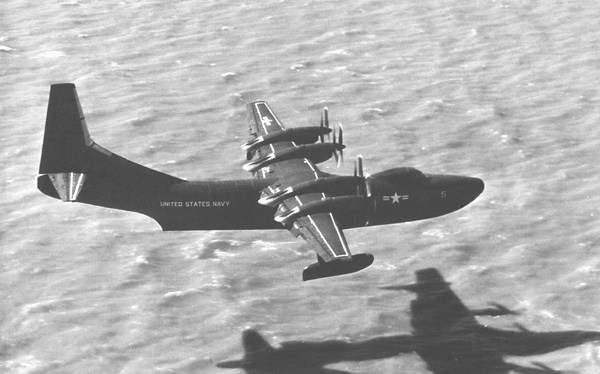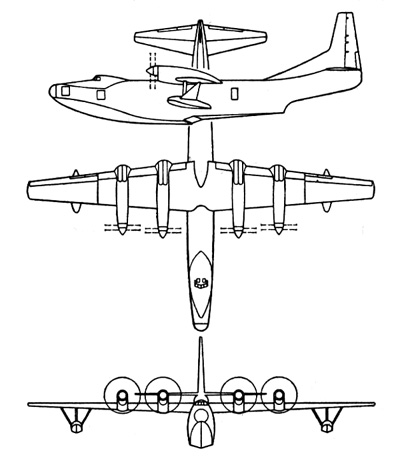
|
 |
Convair R3Y Tradewind |
 |
 |
 |
 |
 |
|---|---|---|---|---|---|---|---|
 |
 |
 |
 |
 |
|||
 |
|||
| The year 1945 saw WWII wind down and each of the armed services try to evaluate the equipment they had fought with. The Navy concluded most of their aircraft had done well. By August 1945, the United States Navy was ostensibly the most powerful and modern in the world. Their flying boats had done well enough, but with the technology developed during the war, the Navy felt this class of aircraft could be greatly improved. What with the development of the turboprop engine and thin, high-lift wings, the Navy could increase payload, speed and effectiveness to a degree unheard of just a few years back. | |||
| In 1945, the Navy approached Convair to see what could be done and Convair came up with the Model 117. It was a very sleek, high wing boat with a single-step hull, four Allison T-40 turboprop engines with six blade, contra-rotating props. Each engine developed 5,100 shaft hp (3,806 kW) and 830 pounds (376 kg) of jet thrust. The stabilizing floats were fixed, as there was no room to stow them in the thin, laminar-flow wing. The boat was named the "Tradewind". It first flew in 1950 after a delay of some months because of trouble with the Allison engines. The Navy received it first Tradewind in 1954. | |||

The Convair Tradewind set a record in 1956 when it simultaneously refueled four The Navy sought to use it as a patrol craft, troop transport, flying ambulance and fuel tanker. As a patrol craft, it mounted 5 pairs of 20 mm guns, two on each side fore and aft, and one pair behind the rudder. The Tradewind could lift 8,000 lbs. (3,629 kg) of stores. It had a range of 3,450 miles (5,552 km) without stores. In this configuration, the Navy called it the "P5Y". In the troop transport/ambulance arrangement, it was called the "R3Y" and could carry 103 fully armed troops or 92 stretcher patients and 12 Medics. The fuel tanker model was also called the R3Y. It was this model which went into the history books in 1954 when it set a transcontinental seaplane speed record of 403 miles per hour utilizing the jetstream. It again set a record in 1956 when it simultaneously refueled four F9F Cougars in-flight. The speed record still stands.

At various times, the Navy had further plans to use the P5Y as an assault boat, a nuclear powered aircraft and several other configurations. Engine problems ultimately blocked these plans. Two P5Ys, five R3Y-1s and six R3Y-2 Tradewinds were built before production was halted, What should have been one of the Navy's best and most beautiful boats was destined to be very short lived. The Allison T-40 engines were troubled from the start and the problems were never adequately remedied. One of the two original XP5Y-1s crashed and the suspected cause was engine failure. Subsequently, several more of the R3Ys were wrecked and it was judged definitely due to faulty engines. Finally, in 1958 the Navy ordered them grounded and sold for scrap. | |||
| Specifications: | |
|---|---|
| Convair Tradewind R3Y-1 | |
| Dimensions: | |
| Wing span: | 145 ft 9 in (44.42 m) |
| Length: | 139 ft 8 in (42.26 m) |
| Height: | 51 ft 5 in (15.68 m) |
| Wing Area: | 2,102 sq ft (640 sq m) |
| Weights: | |
| Empty: | 71,824 lbs (32,579 kg) |
| Normal Gross: | 145,500 lbs (65,998 kg) |
| Maximum Gross: | 165,000 lbs (74,842 kg) |
| Performance: | |
| Maximum Speed: |
388 mph (624 km/hr) @ 30,000 ft (9,144 m) 372 mph (598 km/hr) @ sea level) |
| Cruising Speed: | 225 mph (362 km/hr) |
| Service Ceiling: | 39,700 ft (12,100 m) |
| Combat Range: | 2,785 mi (4,482 km) with eight 325 lb depth charges |
| Maximum Range: | 3,450 mi (5,552 km) without payload |
| Powerplant: | |
|
Four Allison T-40-A-4 rated 5,100 shaft hp (3,806 kW) plus 830 lbs. (376.48 kg) jet thrust | |
| Armament: | |
| No Armament on R3Y Versions. | |
Earl Swinhart © The Aviation History On-Line Museum.
All rights reserved.
Created August 4, 2000. Updated October 13, 2013.